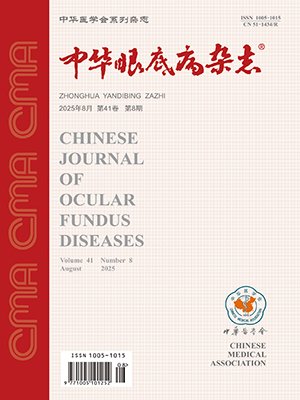| 1. |
Wong WL, Su X, Li X, et al. Global prevalence of agerelated macular degeneration and disease burden projection for 2020 and 2040: a systematic review and meta-analysis[J]. Lancet Glob Health, 2014, 2(2): 106-116. DOI: 10.1016/S2214-109X(13)70145-1.
|
| 2. |
Brown DM, Kaiser PK, Michels M, et al. Ranibizumab versus verteporfin for neovascular age-related macular degeneration[J]. N Engl J Med, 2006, 355(14): 1432-1444. DOI: 10.1056/NEJMoa062655.
|
| 3. |
Brown DM, Michels M, Kaiser PK, et al. Ranibizumab versus verteporfin photodynamic therapy for neovascular age-related macular degeneration: two-year results of the ANCHOR study[J]. Ophthalmology, 2009, 116(1): 57-65. DOI: 10.1016/j.ophtha.2008.10.018.
|
| 4. |
Treatment of age-related macular degeneration with photodynamic therapy (TAP) Study Group. Photodynamic therapy of subfoveal choroidal neovascularization in age-related macular degeneration with verteporfin: one-year results of 2 randomized clinical trials-TAP report[J]. Arch Ophthalmol, 1999, 117(10): 1329-1345. DOI: 10.1001/archopht.117.10.1329.
|
| 5. |
陈有信, 葛坚, 严密, 等. 中国维替泊芬光动力疗法治疗年龄相关性黄斑变性中心凹下脉络膜新生血管的多中心临床研究[J]. 中华眼科杂志, 2007, 43(3): 198-205. DOI: 10.3760/j.issn.0412-4081.2007.03.003.Chen YX, Ge J, Yan M, et al. Clinical trial of verteporfin photodynamic therapy in Chinese age-related macular degeneration with subfoveal predominant choroidal neovascularization patients[J]. Chin J Ophthalmol, 2007, 43(3): 198-205. DOI: 10.3760/j.issn.0412-4081.2007.03.003.
|
| 6. |
Yoon JU, Byun YJ, Koh HJ. Intravitreal anti-VEGF versus photodynamic therapy with verteporfin for treatment of myopic choroidal neovascularization[J]. Retina, 2010, 30(3): 418-424. DOI: 10.1097/IAE.0b013e3181bd2fe4.
|
| 7. |
Heier JS, Brown DM, Chong V, et al. Intravitreal aflibercept (VEGF trap-eye) in wet age-related macular degeneration[J]. Ophthalmology, 2012, 119(12): 2537-2548. DOI: 10.1016/j.ophtha.2012.09.006.
|
| 8. |
Schmidt-Erfurth U, Kaiser PK, Korobelnik JF, et al. Intravitreal aflibercept injection for neovascular age-related macular degeneration: ninety-six-week results of the VIEWstudies[J]. Ophthalmology, 2014, 121(1): 193-201. DOI: 10.1016/j.ophtha.2013.08.011.
|
| 9. |
Wong TY, Ogura Y. 2-year (96-week) efficacy and safety of intravitreal aflibercept injection for neovascular age-related macular degeneration in Asian patients: subgroup analysis of VIEW studies[C]. World Ophthalmology Congress, Tokyo, Japan, 2014.
|
| 10. |
Sivaprasad S, Saleh GM, Jackson H. Does lesion size determine the success rate of photodynamic therapy for agerelated macular degeneration?[J]. Eye (Lond.), 2006, 20(1): 43-45. DOI: 10.1038/sj.eye.6701787.
|
| 11. |
Verteporfin Roundtable Participants. Guidelines for using verteporfin (Visudyne) in photodynamic therapy for choroidal neovascularization due to age-related macular degeneration and other causes: update[J]. Retina, 2005, 25(2): 119-134. DOI: 10.1097/00006982-200502000-00002.
|
| 12. |
Suner IJ, Kokame GT, Yu E, et al. Responsiveness of NEI VFQ-25 to changes in visual acuity in neovascular AMD: validation studies from two phase 3 clinical trials[J]. Invest Ophthalmol Vis Sci, 2009, 50(8): 3629-3635. DOI: 10.1167/iovs.08-3225.
|
| 13. |
Brown DM, Shapiro H, Schneider S. Subgroup analysis of first-year results of ANCHOR: a phase Ⅲ, double-masked, randomized comparison of ranibizumab and verteporfin photodynamic therapy for predominantly classic choroidal neovascularization related to age-related macular degeneration[J]. Invest Ophthalmol Vis Sci, 2006, 47: 2963.
|
| 14. |
Kaiser PK, Brown DM, Zhang K, et al. Ranibizumab for predominantly classic neovascular age-related macular degeneration: subgroup analysis of first-year ANCHOR results[J]. Am J Ophthalmol, 2007, 144(6): 850-857. DOI: 10.1016/j.ajo.2007.08.012.
|
| 15. |
ICH Harmonised Tripartite Guideline. Ethnic factors in the acceptability of foreign clinical data EH(R1)[EB/OL](2016-04-18). http://www.ich.org/products/guidelines/efficacy/article/efficacyguidelines.html.
|




